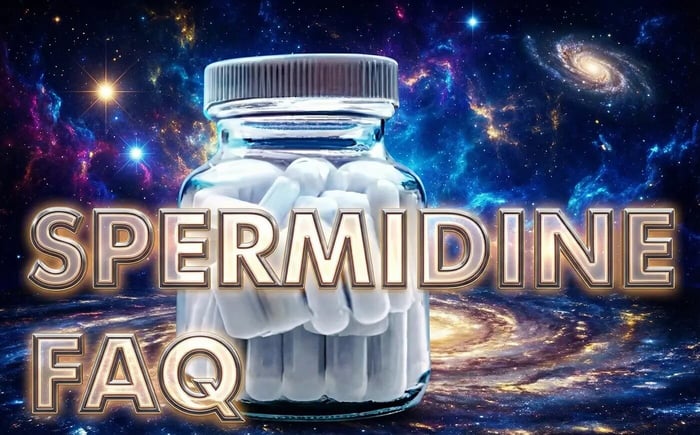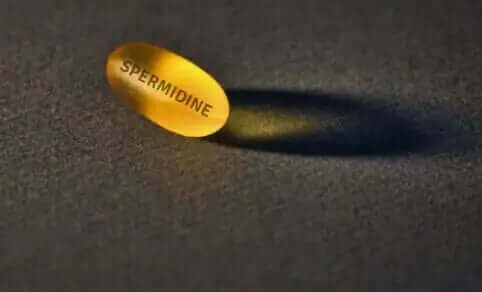Spermidine: The Complete Guide to This Revolutionary Anti-Aging Compound
Spermidine stands at the forefront of longevity science, offering remarkable potential for those seeking to optimize their healthspan and combat age-related decline. This naturally occurring polyamine has captured the attention of researchers worldwide for its ability to mimic the cellular benefits of caloric restriction without the need for dietary limitations. Whether you're exploring ways to support healthy aging, enhance cellular function, or simply understand what makes Spermidine such a breakthrough discovery, this comprehensive guide provides everything you need to know about this extraordinary compound.
As we age, our bodies face declining levels of essential compounds that keep our cells functioning optimally. Spermidine represents a powerful solution to this challenge, offering scientifically-proven benefits that range from cardiovascular support to enhanced cognitive function. Understanding how Spermidine works and why supplementation becomes increasingly important with age can transform your approach to healthy longevity.

Understanding Spermidine: Nature's Cellular Renewal Compound
Spermidine belongs to a fascinating class of molecules called polyamines, characterized by their short carbon chains containing multiple nitrogen-based amine groups. This molecular structure gives Spermidine its unique ability to interact with various cellular processes essential for maintaining optimal health. Found throughout nature in all living organisms from bacteria to humans, Spermidine plays a fundamental role in cellular growth, proliferation, and tissue regeneration.
The universal presence of Spermidine across all forms of life underscores its critical importance. Just as DNA serves as the blueprint for life in every organism, polyamines like Spermidine facilitate the cellular processes that keep life thriving. This compound stabilizes both DNA and RNA, provides powerful antioxidant protection, modulates enzyme functions, influences protein translation, and regulates programmed cell death (apoptosis).
The Three Sources of Spermidine in Your Body
Your body obtains Spermidine through three distinct pathways, each playing a vital role in maintaining adequate levels:
- Cellular Production: Your cells naturally synthesize Spermidine as part of normal metabolic processes. However, this internal production declines significantly with age, contributing to the age-related decrease in Spermidine levels that researchers have observed across populations.
- Gut Microbiome Synthesis: The beneficial bacteria residing in your intestinal tract produce Spermidine that your body can absorb and utilize. Unfortunately, the composition of gut flora changes as we age, often resulting in reduced Spermidine production from this important source.
- Dietary Intake: Various foods contain Spermidine, providing an external source of this vital compound. While a balanced diet can contribute to Spermidine levels, maintaining consistently high intake through food alone proves challenging for most people.
The convergence of declining production, altered gut flora, and inconsistent dietary intake creates a perfect storm for Spermidine deficiency as we age. This reality has sparked intense interest in Spermidine supplementation as a practical solution for maintaining optimal levels throughout life.
Why Spermidine Matters: The Science of Cellular Rejuvenation
The importance of Spermidine extends far beyond its individual cellular functions. At the organismal level, adequate Spermidine levels correlate with reduced incidence of age-related diseases and improved overall healthspan. Research has demonstrated that Spermidine helps protect against cardiovascular diseases, neurodegenerative conditions, autoimmune disorders, various cancers, and age-related memory impairment.
These wide-ranging benefits stem from Spermidine's fundamental role in cellular maintenance and renewal. By supporting autophagy (the cellular recycling process), stabilizing genetic material, and providing antioxidant protection, Spermidine helps cells function optimally even as chronological age advances.
Spermidine as a Caloric Restriction Mimetic
One of the most exciting aspects of Spermidine research involves its classification as a caloric restriction mimetic. Caloric restriction, defined as reducing calorie intake while maintaining nutritional balance, remains the most studied and reliable method for extending lifespan across virtually all tested organisms. The challenge lies in the difficulty of maintaining such restrictive diets long-term.
Spermidine offers a remarkable solution by mimicking the cellular effects of caloric restriction without requiring dietary limitations. Like caloric restriction, Spermidine enhances autophagy and promotes the deacetylation of cellular molecules, triggering many of the same beneficial pathways that lead to extended healthspan and reduced age-related pathologies.
This mimetic effect places Spermidine alongside other renowned longevity compounds like rapamycin and resveratrol. However, Spermidine's natural occurrence in the body and its excellent safety profile make it particularly attractive for long-term supplementation strategies.
Comprehensive Health Benefits of Spermidine
Scientific research has revealed an impressive array of health benefits associated with optimal Spermidine levels. These findings come from studies conducted across various model organisms and human populations, providing robust evidence for Spermidine's therapeutic potential:
Longevity and Healthspan Enhancement
- Extended Lifespan: Diets rich in Spermidine have been shown to extend both lifespan and fitness in multiple studies
- Improved Autophagy: Spermidine enhances cellular recycling processes essential for longevity
- Circadian Rhythm Support: Research indicates Spermidine helps reduce age-associated disruptions to natural sleep-wake cycles
Cardiovascular Health Protection
- Blood Pressure Reduction: Spermidine has been observed to reduce both systolic and diastolic blood pressure
- Atherosclerosis Prevention: Studies show Spermidine helps alleviate arterial plaque formation
- Arterial Flexibility: Spermidine reduces age-induced arterial stiffness, supporting healthy circulation
- Cardiac Muscle Function: Research demonstrates improved mitochondrial function in heart muscle cells
Cancer Prevention and Immune Support
- Tumor Suppression: Spermidine has shown ability to reduce tumor formation and liver cell carcinomas
- Colorectal Cancer Protection: Studies indicate Spermidine slows the growth of colorectal cancers
- Enhanced Immune Response: Spermidine increases the body's natural anti-cancer immune responses
Metabolic and Weight Management Benefits
- Fat Cell Prevention: Spermidine helps prevent the buildup of adipocytes (fat cells)
- Glucose Tolerance: Research shows improved glucose metabolism with Spermidine supplementation
- Weight Loss Support: Spermidine-induced autophagy supports healthy weight loss and helps counteract weight gain
Musculoskeletal and Neurological Support
- Osteoporosis Prevention: Studies have observed reduced bone density loss with Spermidine
- Muscle Regeneration: Spermidine reverses age-associated defects in muscle stem cell autophagy
- Multiple Sclerosis Models: Experimental studies show Spermidine stops encephalomyelitis progression
How to Optimize Your Spermidine Levels
Given the age-related decline in Spermidine production and the challenges of maintaining adequate levels through diet alone, supplementation emerges as a practical strategy for optimization. When considering Spermidine supplementation, several factors contribute to success:
Dietary Sources of Spermidine
While supplementation offers the most reliable method for maintaining optimal levels, incorporating Spermidine-rich foods into your diet provides additional support:
- Wheat germ
- Aged cheese
- Mushrooms
- Soy products
- Legumes
- Corn
- Whole grains
Supplementation Strategies
High-quality Spermidine supplements offer standardized doses that ensure consistent intake. When selecting a supplement, look for products that provide pure Spermidine derived from natural sources, with third-party testing for quality assurance.
Supporting Gut Health
Since gut bacteria contribute to Spermidine production, maintaining a healthy microbiome through probiotics and prebiotic foods can enhance your body's natural synthesis capabilities.
The Future of Spermidine Research
As research into Spermidine continues to expand, scientists are uncovering new mechanisms and applications for this remarkable compound. Current investigations explore Spermidine's potential in treating specific age-related conditions, optimizing dosing protocols, and understanding individual variations in response to supplementation.
The growing body of evidence supporting Spermidine's benefits has led to increased interest from both the scientific community and health-conscious individuals seeking evidence-based approaches to healthy aging. As our understanding deepens, Spermidine may well become a cornerstone of personalized longevity protocols.
Making Spermidine Part of Your Longevity Strategy
Incorporating Spermidine into your health regimen represents a scientifically-supported approach to promoting cellular health and combating age-related decline. Whether through dietary optimization, targeted supplementation, or a combination of both, maintaining adequate Spermidine levels offers tangible benefits for those committed to healthy aging.
The convergence of traditional wisdom about the importance of certain foods with modern scientific understanding of Spermidine's mechanisms creates an exciting opportunity. By harnessing the power of this natural compound, we can support our bodies' innate capacity for cellular renewal and resilience.
As you consider adding Spermidine to your wellness routine, remember that consistency matters. The cellular processes supported by Spermidine operate continuously, making regular intake essential for optimal benefits. Combined with other healthy lifestyle practices, Spermidine supplementation can play a vital role in your journey toward enhanced vitality and longevity.
Frequently Asked Questions About Spermidine
What exactly is Spermidine and why is it important?
Spermidine is a naturally occurring polyamine compound found in all living organisms. It plays crucial roles in cellular growth, DNA stabilization, autophagy enhancement, and antioxidant protection. As we age, our body's Spermidine levels decline, which correlates with increased risk of age-related diseases. Supplementing with Spermidine helps restore optimal levels, supporting healthy aging and reducing the risk of cardiovascular disease, neurodegeneration, and other age-related conditions.
How does Spermidine mimic caloric restriction?
Spermidine activates similar cellular pathways as caloric restriction, particularly autophagy (cellular recycling) and molecular deacetylation. These processes are key to the life-extending benefits of caloric restriction. By taking Spermidine supplements, you can achieve many of the same cellular benefits without the challenges of maintaining a restricted diet, making it an attractive option for those seeking the longevity benefits of caloric restriction through a more sustainable approach.
What are the main health benefits of taking Spermidine?
Research has shown that Spermidine offers numerous health benefits including: extended lifespan and improved fitness, reduced blood pressure and cardiovascular disease risk, enhanced immune function and cancer protection, improved glucose metabolism and weight management, stronger bones and muscle regeneration, and better cognitive function with reduced neurodegeneration. These benefits stem from Spermidine's fundamental role in cellular maintenance and renewal.
Why do Spermidine levels decline with age?
Spermidine levels decline due to three main factors: First, our cells naturally produce less Spermidine as we age. Second, changes in gut microbiome composition reduce bacterial Spermidine production. Third, dietary habits and absorption efficiency often decrease with age. This triple decline makes supplementation increasingly important for maintaining optimal Spermidine levels as we get older.
What foods are naturally high in Spermidine?
Foods rich in Spermidine include wheat germ, aged cheeses (particularly blue cheese and cheddar), mushrooms, soy products like tempeh and natto, legumes such as peas and lentils, corn, and whole grains. However, maintaining consistently high Spermidine intake through diet alone can be challenging, which is why many people choose to supplement for optimal levels.
Is Spermidine safe for long-term supplementation?
Spermidine has an excellent safety profile, being a naturally occurring compound that our bodies produce and obtain from food. Multiple studies have shown no adverse effects from Spermidine supplementation, even with long-term use. As with any supplement, it's wise to choose high-quality products from reputable manufacturers and consult with healthcare providers if you have specific health conditions.
How does Spermidine support cardiovascular health?
Spermidine supports cardiovascular health through multiple mechanisms: it reduces both systolic and diastolic blood pressure, helps prevent atherosclerotic plaque formation, maintains arterial flexibility by reducing age-induced stiffness, and improves mitochondrial function in cardiac muscle cells. These combined effects significantly reduce the risk of heart disease and support overall cardiovascular function throughout aging.
Can Spermidine help with weight management?
Yes, Spermidine can support healthy weight management. Research shows that Spermidine prevents the buildup of fat cells (adipocytes), improves glucose tolerance and insulin sensitivity, and the autophagy induced by Spermidine is required for healthy weight loss. Additionally, Spermidine helps counteract age-related weight gain, making it a valuable tool for maintaining healthy body composition as we age.
What makes Spermidine different from other anti-aging supplements?
Spermidine stands out because it's a naturally occurring compound essential for life in all organisms, has multiple mechanisms of action including autophagy enhancement and DNA stabilization, and offers proven benefits across multiple body systems. Unlike some anti-aging compounds, Spermidine has an excellent safety profile with no known side effects, and it works as a caloric restriction mimetic, providing longevity benefits without dietary restrictions.
How long does it take to see benefits from Spermidine supplementation?
The timeline for experiencing benefits from Spermidine supplementation varies depending on individual factors and specific health goals. Some cellular benefits like enhanced autophagy begin immediately, while noticeable improvements in energy, cardiovascular markers, or cognitive function may take several weeks to months. Long-term benefits for healthspan and disease prevention accumulate over months and years of consistent supplementation. Regular use is key to maximizing Spermidine's protective effects.




